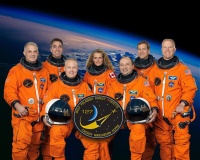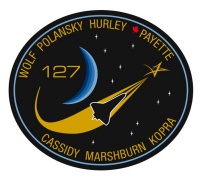STS-127
From The Space Library
 | |
| Organization | NASA-Office of Space Flight (United States) |
|---|---|
| Mission type | Human Crew,Resupply/Refurbishment/Repair |
| Launch date | July 15, 2009 |
| Launch vehicle | Space Shuttle |
| Launch site | Cape Canaveral, United States |
| COSPAR ID | 2009-038A |
| Inclination | 51.6 degrees |
| Experiments | Here |
| Alternate Names | 35633 |
| Additional Information | Here |
| Data Collection | Here |
| Payload Mass Up | 11175.6 kg |
| Payload Mass Down | 4763.18 kg |
| Orbiter | Endeavour |
| Lift Off Mass | 2,054,091.82 kg |
| Orbiter Weight at Liftoff | 120,090.00 kg |
| Orbiter Weight at Landing | 97,612.27 kg |
| Landed | 10:48 a.m. EDT, concrete runway 15, Kennedy Space Center, Fla. |
| Orbits of Earth | 248 |
| Orbital Altitude | 191 nautical miles |
Contents |
[edit] Crew
- Commander: Mark L. Polansky
- Pilot: Douglas G. Hurley
- Payload Commander:
- Mission Specialist 1: Christopher J. Cassidy
- Mission Specialist 2: Thomas H. Marshburn
- Mission Specialist 3: Julie Payette, Canadian Space Agency
- Mission Specialist 4: David A. Wolf
- Mission Specialist 5:
- Payload Specialist 1:
- Payload Specialist 2:
ISS/Mir Crew Transport
- Timothy L. Kopra - up only Koichi Wakata - down only
[edit] Mission
STS 127 is an American shuttle craft carrying seven astronauts launched from Cape Canaveral on 15 July 2009 at 22:03 UT. The shuttle docked with the International Space Station (ISS) on 17 July 2009 at 17:47 UT. The primary objective of this 16 day mission was to install the final components of the Japanese Kibo module to the ISS. During five spacewalks, astronauts installed and equipped the new component to the Kibo and replaced aging batteries and installed spare parts on the ISS. The shuttle also delivered a new crew member to the ISS and returned another to Earth. The STS 127 mission concluded with a landing at Cape Canaveral on 31 July 2009 at 14:48 UT.
[edit] EVA
Extravehicular Activity (EVA) conducted by David Wolf, Timothy Kopra, Thomas Marshburn, and Christopher Cassidy during five spacewalks for a total of 30 hours, 30 minutes. The spacewalkers were assisted by Mark Polansky and Julie Payette using the shuttle's Canadarm and Koichi Wakata and Douglas Hurley using the ISS Canadarm2. EVA 1, 5 hours, 32 minutes; Wolf and Kopra prepared the berthing mechanisms on the Kibo lab and the JEF for the installation. They also completed deploying an unpressurized cargo carrier attachment system on the P3 truss that had failed to unfurl during STS-119. EVA 2, 6 hours, 53 minutes; Wolf and Marshburn removed three hardware spares from an Integrated Cargo Carrier and attached them to a stowage platform on the P3 truss for long-term storage. EVA 3, 5 hours, 59 minutes; Wolf and Cassidy replaced two of six old solar array batteries on the P6 truss. These batteries were the oldest ones on the space station and were located at the end of the port side truss, hundreds of feet from the station's core. Each battery weighed 367 pounds and was the size of a refrigerator. It was originally planned to replace four batteries on EVA 3, but the spacewalk was ended early when it appeared there was a potential problem with the carbon dioxide scrubbing device on Cassidy's spacesuit. EVA 4, 7 hours, 12 minutes; Cassidy and Marshburn replaced the remaining four solar array batteries on the P6 truss. EVA 5, 4 hours, 54 minutes; Cassidy and Marshburn installed video cameras on the front and back of the new JEM - EF, secured multilayer insulation around Dextre, split out power channels for two control moment gyroscopes, tied down cables, and installed handrails and a portable foot restraint.
[edit] Payload
ISS Assembly Flight 2J/A; Kibo Japanese Experiment Module Exposed Facility (JEM - EF), Kibo Japanese Experiment Logistics Module - Exposed Section (ELM - ES); Integrated Cargo Carrier (ICC); crew exchange
[edit] Books about the Space Shuttle Program
Buy This Book Click here |
Buy This Book here |
Buy This Book Click here |
Buy This Book Click here |





